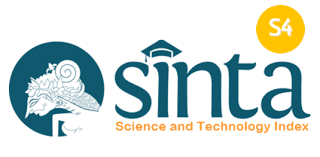INCREASE EXPRESSED BREAST MILK PRODUCTION IN BREASTFEEDING MOTHERS A SCOOPING REVIEW
Abstract
Abstrak
Latar Belakang: Pentingnya ASI didukung dengan baik oleh Organisasi Kesehatan Dunia yang merekomendasikan bahwa semua bayi harus diberi ASI eksklusif sejak lahir sampai usia 6 bulan dan dilanjutkan pemberian makanan pendamping yang sesuai. Tidak semua bayi dapat menyusu melalui payudara sehingga ASI sangat dibutuhkan. Bayi yang tidak mendapatkan ASI lebih beresiko mengalami masalah kesehatan, baik saat baru lahir maupun di kemudian hari. Ibu mungkin juga ingin memerah ASI untuk kenyamanan mereka sendiri atau untuk meningkatkan volume ASI perahnya. Metode: Ulasan ini menggunakan pendekatan Arksey dan O'Malley. Pencarian artikel melalui Pubmed, Cochrane dan Science Direct yang diterbitkan tahun 2013-2020 didapatkan 106 artikel. Pemilihan artikel menggunakan PRISMA framework, terpilih 6 artikel untuk direview. Metode pemerahan ASI yang paling sesuai dapat dipengaruhi faktor, yaitu waktu memulai pemerahan ASI sejak lahir, tujuan pemerahan, dan kondisi kesehatan ibu dan bayi. Intervensi berbiaya rendah termasuk inisiasi dini pemompaan saat tidak menyusui secara langsung dari payudara, relaksasi, pemerahan menggunakan tangan, dan pompa berbiaya lebih rendah mungkin sama efektifnya, atau lebih efektif, daripada pompa listrik besar untuk beberapa hasil pemompaan. Hal penting untuk meningkatkan ASI perah adalah frekuensi dan lama sesi pemompaan
Kata kunci: Menyusui, Memompa ASI, ASI perah, Menyusui
Abstract
Background: According to the World Health Organization, all infants must be fed only human milk from birth to six months of age, with appropriate additional foods offered after that. Expressed milk is required since not all newborns are able to feed themselves at the breast. Breastfed babies are more likely to suffer health problems later in life than those who are not breastfed as neonates. For personal comfort or to improve production, mothers may choose to express their milk. Method: This scoping review adopts Arksey and O'Malley's framework. Article search through Pubmed, Cochrane and Science Direct published in 2013-2020 found 106 articles. Article selection using the PRISMA framework, 6 articles were selected for review. Depending on length of time after birth, the purpose of expression, and the mother and newborn, the ideal method for milk expression may vary. Low-cost interventions, such as early initiation while not lactating, were shown to increase some outcomes, relaxation, hand expression, and lower-cost pumps may be as effective as, if not more effective than, large electric pumps. The important things to increase expressed breast milk are frequency and pumping session length.
Keywords
Full Text:
PDFReferences
Arksey, H., & Malley Lo. Scoping Studies: Towards A Methodological Framework. 19-32. 2005;
Moher D, Liberati A, Tetzlaff J, Altman Dg. Preferred Reporting Items For Systematic Reviews And Meta-Analyses: The Prisma Statement. J Clin Epidemiol. 2009;62(10):1006-12.
Rezekiyah S, Lestari Ws, Fitriana E, Karwiti W, Riska Dm. Of Natrium Fluorid ( Naf ) Plasma Blood Glucoselevels Laboratorium. Jambura J Heal Sci Res. 2021;3(2):162-8.
Héon M, Goulet C, Garofalo C, Nuyt AM, Levy E. An Intervention To Promote Breast Milk Production In Mothers Of Preterm Infants. West J Nurs Res. 2016;38(5):529-52.
Gardner H, Kent JC, Lai CT, Mitoulas LR, Cregan MD, Hartmann PE, Et Al. Milk Ejection Patterns: An Intra- Individual Comparison Of Breastfeeding And Pumping. BMC Pregnancy Childbirth. 2015;15(1):1-6.
Wu B, Zheng J, Zhou M, Xi X, Wang Q, Hua J, Et Al. Improvement Of Expressed Breast Milk In Mothers Of Preterm Infants By Recording Breast Milk Pumping Diaries In A Neonatal Center In China. Plos One. 2015;10(12):1-10.
Johns HM, Forster DA, Amir LH, Mclachlan HL. Prevalence And Outcomes Of Breast Milk Expressing In Women With Healthy Term Infants: A Systematic Review. BMC Pregnancy Childbirth. 2013;13.
Bai DL, Fong DYT, Lok KYW, Wong JYH, Tarrant M. Practices, Predictors And Consequences Of Expressed Breast-Milk Feeding In Healthy Full-Term Infants. Public Health Nutr. 2017;20(3):492-503.
Pang WW, Bernard JY, Thavamani G, Chan YH, Fok D, Soh SE, Et Al. Direct Vs. Expressed Breast Milk Feeding: Relation To Duration Of Breastfeeding. Nutrients. 2017;9(6):1-13.
Levac D, Colquhoun H, O'Brien KK. Scoping Studies: Advancing The Methodology. Implement Sci. 2010;5(1):1-9.
Sugawara E, Nikaido H. Properties Of Adeabc And Adeijk Efflux Systems Of Acinetobacter Baumannii Compared With Those Of The Acrab-Tolc System Of Escherichia Coli. Antimicrob Agents Chemother [Internet]. 2014 Dec;58(12):7250-7. Available From: Http://Www.Ncbi.Nlm.Nih.Gov/Pubmed/25246403
DOI: https://doi.org/10.35971/jjhsr.v4i0.12561
Refbacks
- There are currently no refbacks.

This work is licensed under a Creative Commons Attribution-ShareAlike 4.0 International License.
Jambura Journal of Health Sciences and Research is licensed under a Creative Commons Attribution-ShareAlike 4.0 International License
</p



_.png)




_edit.png)




